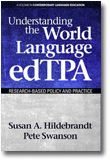
Understanding the World Language edTPA
Research‐Based Policy and Practice
By:
Susan A. Hildebrandt, Illinois State University
Peter B. Swanson, Georgia State University
A volume in the series: Contemporary Language Education. Editor(s): Terry Osborn, University of South Florida.
Published 2016
In Understanding the World Language edTPA: Research‐Based Policy and Practice, two researchers in the forefront of world language edTPA discuss the new beginning teacher portfolio, including its required elements, federal and state policies concerning teacher evaluation, and research from their own programs. Higher education faculty members and language teacher preparation program coordinators who would like to better understand edTPA requirements and gain suggestions for necessary programmatic changes will find this book of interest.
The book is composed of eight chapters. The authors begin by describing edTPA and how it became a national trend to assess beginning teacher ability. In Chapter 2, the authors present ideas about curricular changes that may need to occur in traditional world language teacher education programs, as well as suggestions to assist teacher candidates as they begin to develop their portfolios. Afterward, the authors discuss the context for learning (Chapter 3) and they begin with assessment, moving to planning, and then to instruction (Chapters 4, 5, 6). In each chapter, the authors discuss the work sample that teacher candidates must create, an analysis of a high‐scoring portfolio, and steps to stimulate teacher candidates’ professional thinking. In Chapter 7, the authors present activities for the methods classroom. In the final chapter, the authors provide a critical analysis of edTPA, in general, and the world language edTPA, in particular.
Understanding the World Language edTPA: Research‐Based Policy and Practice provides readers with a much‐needed guide to inducting teacher candidates into the new portfolio requirements, while helping higher education faculty make appropriate curricular changes to accommodate edTPA.
CONTENTS
Preface. Acknowledgments. CHAPTER I: What is edTPA? CHAPTER II: Getting Started With Program and Course Suggestions. CHAPTER III: Context for Learning. CHAPTER IV: Beginning at the End: Assessing Student Learning. CHAPTER V: Planning for Teaching and Learning. CHAPTER VI: Instructing and Engaging Students in Learning. CHAPTER VII: Activities for the Methods Classroom. CHAPTER VIII: Concluding Thoughts. References. Appendixes. About the Authors.
-
Paperback9781681235783
Web price: $45.04 (Reg. 52.99)
-
Hardcover9781681235790
Web price: $80.74 (Reg. 94.99)
- eBook9781681235806

- EDU000000 - EDUCATION: General
- EDU015000 - EDUCATION: Higher
- EDU018000 - EDUCATION: Language Experience Approach
-
 Democracy and World Language Education
Toward a Transformation
Democracy and World Language Education
Toward a Transformation
-
 How We Take Action
Social Justice in PK-16 Language Classrooms
How We Take Action
Social Justice in PK-16 Language Classrooms
-
 Identifying and Recruiting Language Teachers
A Research-Based Approach
Identifying and Recruiting Language Teachers
A Research-Based Approach
-
 Intercultural Competence in Instructed Language Learning
Bridging Theory and Practice
Intercultural Competence in Instructed Language Learning
Bridging Theory and Practice
-
 Researching edTPA Promises and Problems
Perspectives from English as an Additional Language, English Language Arts, and World Language Teacher Education
Researching edTPA Promises and Problems
Perspectives from English as an Additional Language, English Language Arts, and World Language Teacher Education
-
 Starting Points in Critical Language Pedagogy
Starting Points in Critical Language Pedagogy
-
 The Seal of Biliteracy
Case Studies and Considerations for Policy Implementation
The Seal of Biliteracy
Case Studies and Considerations for Policy Implementation

